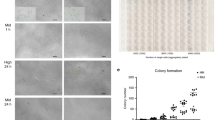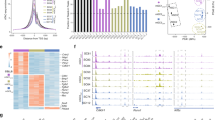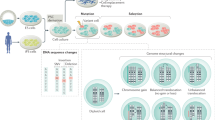Abstract
The International Stem Cell Initiative characterized 59 human embryonic stem cell lines from 17 laboratories worldwide. Despite diverse genotypes and different techniques used for derivation and maintenance, all lines exhibited similar expression patterns for several markers of human embryonic stem cells. They expressed the glycolipid antigens SSEA3 and SSEA4, the keratan sulfate antigens TRA-1-60, TRA-1-81, GCTM2 and GCT343, and the protein antigens CD9, Thy1 (also known as CD90), tissue-nonspecific alkaline phosphatase and class 1 HLA, as well as the strongly developmentally regulated genes NANOG, POU5F1 (formerly known as OCT4), TDGF1, DNMT3B, GABRB3 and GDF3. Nevertheless, the lines were not identical: differences in expression of several lineage markers were evident, and several imprinted genes showed generally similar allele-specific expression patterns, but some gene-dependent variation was observed. Also, some female lines expressed readily detectable levels of XIST whereas others did not. No significant contamination of the lines with mycoplasma, bacteria or cytopathic viruses was detected.
This is a preview of subscription content, access via your institution
Access options
Subscribe to this journal
Receive 12 print issues and online access
$209.00 per year
only $17.42 per issue
Buy this article
- Purchase on SpringerLink
- Instant access to full article PDF
Prices may be subject to local taxes which are calculated during checkout






Similar content being viewed by others
References
Allegrucci, C. & Young, L.E. Differences between human embryonic stem cell lines. Hum. Reprod. Update 13, 103–120 (2006).
Pera, M.F., Roach, S. & Ellis, C.J. Comparative biology of mouse and human embryonal carcinoma. Cancer Suveys 9, 243–262 (1990).
Andrews, P.W. From teratocarcinomas to embryonic stem cells. Phil. Trans. R. Soc. Lond. B 357, 405–417 (2002).
Ginis, I. et al. Differences between human and mouse embryonic stem cells. Dev. Biol. 269, 360–380 (2004).
Andrews, P.W. et al. The International Stem Cell Initiative: toward benchmarks for human embryonic stem cell research. Nat. Biotechnol. 23, 795–797 (2005).
Brimble, S.N. et al. Karyotypic stability, genotyping, differentiation, feeder-free maintenance, and gene expression sampling in three human embryonic stem cell lines derived prior to August 9, 2001. Stem Cells Dev. 13, 585–597 (2004).
Dvash, T. et al. Temporal gene expression during differentiation of human embryonic stem cells and embryoid bodies. Hum. Reprod. 19, 2875–2883 (2004).
Sperger, J.M. et al. Gene expression patterns in human embryonic stem cells and human pluripotent germ cell tumors. Proc. Natl. Acad. Sci. USA 100, 13350–13355 (2003).
Brandenberger, R. et al. MPSS profiling of human embryonic stem cells. BMC Dev. Biol. 4, 10 (2004).
Rao, R.R. et al. Comparative transcriptional profiling of two human embryonic stem cell lines. Biotechnol. Bioeng. 88, 273–286 (2004).
Abeyta, M.J. et al. Unique gene expression signatures of independently-derived human embryonic stem cell lines. Hum. Mol. Genet. 13, 601–608 (2004).
Pera, M.F., Reubinoff, B. & Trounson, A. Human embryonic stem cells. J. Cell Sci. 113, 5–10 (2000).
Nichols, J. et al. Formation of pluripotent stem cells in the mammalian embryo depends on the POU transcription factor OCT4. Cell 95, 379–391 (1998).
Matin, M.M. et al. Specific knockdown of Oct4 and beta2-microglobulin expression by RNA interference in human embryonic stem cells and embryonic carcinoma cells. Stem Cells 22, 659–668 (2004).
Scholer, H.R., Balling, R., Hatzopoulos, A.K., Suzuki, N. & Gruss, P. Octamer binding proteins confer transcriptional activity in early mouse embryogenesis. EMBO J. 8, 2551–2557 (1989).
Mitsui, K. et al. The homeoprotein Nanog is required for maintenance of pluripotency in mouse epiblast and ES cells. Cell 113, 631–642 (2003).
Chambers, I. et al. Functional expression cloning of Nanog, a pluripotency sustaining factor in embryonic stem cells. Cell 113, 643–655 (2003).
Avilion, A.A. et al. Multipotent cell lineages in early mouse development depend on SOX2 function. Genes Dev. 17, 126–140 (2003).
Ciccodicola, A. et al. Molecular characterization of a gene of the 'EGF family' expressed in undifferentiated human NTERA2 teratocarcinoma cells. EMBO J. 8, 1987–1991 (1989).
Bhattacharya, B. et al. Gene expression in human embryonic stem cell lines: unique molecular signature. Blood 103, 2956–2964 (2004).
Richards, M., Tan, S.P., Tan, J.H., Chan, W.K. & Bongso, A. The transcriptome profile of human embryonic stem cells as defined by SAGE. Stem Cells 22, 51–64 (2004).
Ware, C.B., Nelson, A.M. & Blau, C.A. A comparison of NIH-approved human ESC lines. Stem Cells 24, 2677–2684 (2006).
Monk, M., Boubelik, M. & Lehnert, S. Temporal and regional changes in DNA methylation in the embryonic, extraembryonic and germ cell lineages during mouse embryo development. Development 99, 371–382 (1987).
Dean, W. et al. Altered imprinted gene methylation and expression in completely ES cell-derived mouse fetuses: association with aberrant phenotypes. Development 125, 2273–2282 (1998).
Humpherys, D. et al. Epigenetic instability in ES cells and cloned mice. Science 293, 95–97 (2001).
Rugg-Gunn, P.J., Ferguson-Smith, A.C. & Pedersen, R.A. Epigenetic status of human embryonic stem cells. Nat. Genet. 37, 585–587 (2005).
Sun, B.W. et al. Temporal and parental-specific expression of imprinted genes in a newly derived Chinese human embryonic stem cell line and embryoid bodies. Hum. Mol. Genet. 15, 65–75 (2006).
Shevinsky, L.H., Knowles, B.B., Damjanov, I. & Solter, D. Monoclonal antibody to murine embryos defines a stage-specific embryonic antigen expressed on mouse embryos and human teratocarcinoma cells. Cell 30, 697–705 (1982).
Kannagi, R. et al. Stage-specific embryonic antigens (SSEA-3 and -4) are epitopes of a unique globo-series ganglioside isolated from human teratocarcinoma cells. EMBO J. 2, 2355–2361 (1983).
Andrews, P.W., Banting, G., Damjanov, I., Arnaud, D. & Avner, P. Three monoclonal antibodies defining distinct differentiation antigens associated with different high molecular weight polypeptides on the surface of human embryonal carcinoma cells. Hybridoma 3, 347–361 (1984).
Pera, M.F. et al. Analysis of cell-differentiation lineage in human teratomas using new monoclonal antibodies to cytostructural antigens of embryonal carcinoma cells. Differentiation 39, 139–149 (1988).
Andrews, P.W., Meyer, L.J., Bednarz, K.L. & Harris, H. Two monoclonal antibodies recognizing determinants on human embryonal carcinoma cells react specifically with the liver isozyme of human alkaline phosphatase. Hybridoma 3, 33–39 (1984).
Draper, J.S., Pigott, C., Thomson, J.A. & Andrews, P.W. Surface antigens of human embryonic stem cells: changes upon differentiation in culture. J. Anat. 200, 249–258 (2002).
Oka, M. et al. CD9 is associated with leukemia inhibitory factor-mediated maintenance of embryonic stem cells. Mol. Biol. Cell 13, 1274–1281 (2002).
Andrews, P.W., Trinchieri, G., Perussia, B. & Baglioni, C. Induction of class I major histocompatibility complex antigens in human teratocarcinoma cells by interferon without induction of differentiation, growth inhibition, or resistance to viral infection. Cancer Res. 47, 740–746 (1987).
Drukker, M. et al. Characterization of the expression of MHC proteins in human embryonic stem cells. Proc. Natl. Acad. Sci. USA 99, 9864–9869 (2002).
Williams, B.P. et al. Biochemical and genetic analysis of the OKa blood group antigen. Immunogenetics 27, 322–329 (1988).
Fenderson, B.A., Andrews, P.W., Nudelman, E., Clausen, H. & Hakomori, S. Glycolipid core structure switching from globo- to lacto- and ganglio-series during retinoic acid-induced differentiation of TERA-2-derived human embryonal carcinoma cells. Dev. Biol. 122, 21–34 (1987).
Baldassarre, G. et al. Transfection with a CRIPTO anti-sense plasmid suppresses endogenous CRIPTO expression and inhibits transformation in a human embryonal carcinoma cell line. Int. J. Cancer 66, 538–543 (1996).
Enver, T. et al. Cellular differentiation hierarchies in normal and culture-adapted human embryonic stem cells. Hum. Mol. Genet. 14, 3129–3140 (2005).
Kuroda, T. et al. Octamer and Sox elements are required for transcriptional cis regulation of Nanog gene expression. Mol. Cell. Biol. 25, 2475–2485 (2005).
Boyer, L.A. et al. Core transcriptional regulatory circuitry in human embryonic stem cells. Cell 122, 947–956 (2005).
Uwanogho, D. et al. Embryonic expression of the chicken Sox2, Sox3 and Sox11 genes suggests an interactive role in neuronal development. Mech. Dev. 49, 23–36 (1995).
Niwa, H. et al. Interaction between Oct3/4 and Cdx2 determines trophectoderm differentiation. Cell 123, 917–929 (2005).
Koutsourakis, M., Langeveld, A., Patient, R., Beddington, R. & Grosveld, F. The transcription factor GATA6 is essential for early extraembryonic development. Development 126, 723–732 (1999).
Dziadek, M.A. & Andrews, G.K. Tissue specificity of alpha-fetoprotein messenger RNA expression during mouse embryogenesis. EMBO J. 2, 549–554 (1983).
Bishop, K.M., Goudreau, G. & O'Leary, D.D. Regulation of area identity in the mammalian neocortex by Emx2 and Pax6. Science 288, 344–349 (2000).
Lee, J.E. et al. Conversion of Xenopus ectoderm into neurons by NeuroD, a basic helix-loop-helix protein. Science 268, 836–844 (1995).
Martin, G.R. et al. X-chromosome inactivation during differentiation of female teratocarcinoma stem cells in vitro. Nature 271, 329–333 (1978).
Dhara, S.K. & Benvenisty, N. Gene trap as a tool for genome annotation and analysis of X chromosome inactivation in human embryonic stem cells. Nucleic Acids Res. 32, 3995–4002 (2004).
Hoffman, L.M. et al. X-inactivation status varies in human embryonic stem cell lines. Stem Cells 23, 1468–1478 (2005).
Andrews, P.W. et al. Embryonic stem (ES) cells and embryonal carcinoma (EC) cells: opposite sides of the same coin. Biochem. Soc. Trans. 33, 1526–1530 (2005).
Civin, C.I. & Rao, M.S. How many human embryonic stem cell lines are sufficient? A U.S. perspective. Stem Cells 24, 800–803 (2006).
Abbott, A., Dennis, C., Ledford, H. & Smith, K. The lure of stem-cell lines. Nature 442, 336–337 2006).
Brimble, S.N. et al. The Cell Surface Glycosphingolipids SSEA-3 and SSEA-4 are not Essential for Human ES Cell Pluripotency. Stem Cells 25, 54–62 (2006).
Tippett, P., Andrews, P.W., Knowles, B.B., Solter, D. & Goodfellow, P.N. Red cell antigens P (globoside) and Luke: identification by monoclonal antibodies defining the murine stage-specific embryonic antigens -3 and -4 (SSEA-3 and SSEA-4). Vox Sang. 51, 53–56 (1986).
Draper, J.S., Moore, H.D., Ruban, L.N., Gokhale, P.J. & Andrews, P.W. Culture and characterization of human embryonic stem cells. Stem Cells Dev. 13, 325–336 (2004).
Baker, D.E. et al. Adaptation to culture of human embryonic stem cells and oncogenesis in vivo. Nat. Biotechnol. 25, 207–215 (2007).
Henderson, J.K. et al. Preimplantation human embryos and embryonic stem cells show comparable expression of stage-specific embryonic antigens. Stem Cells 20, 329–337 (2002).
Nagy, A. et al. Embryonic stem cells alone are able to support fetal development in the mouse. Development 110, 815–821 (1990).
Xu, C., Liguori, G., Adamson, E.D. & Persico, M.G. Specific arrest of cardiogenesis in cultured embryonic stem cells lacking Cripto-1. Dev. Biol. 196, 237–247 (1998).
Levine, A.J. & Brivanlou, A.H. GDF3, a BMP inhibitor, regulates cell fate in stem cells and early embryos. Development 133, 209–216 (2006).
Mitalipov, S.M. Genomic imprinting in primate embryos and embryonic stem cells. Reprod. Fertil. Dev. 18, 817–821 (2006).
Cooper, P.R. et al. Divergently transcribed overlapping genes expressed in liver and kidney and located in the 11p15.5 imprinted domain. Genomics 49, 38–51 (1998).
Dao, D. et al. IMPT1, an imprinted gene similar to polyspecific transporter and multi-drug resistance genes. Hum. Mol. Genet. 7, 597–608 (1998).
Itskovitz-Eldor, J. et al. Differentiation of human embryonic stem cells into embryoid bodies compromising the three embryonic germ layers. Mol. Med. 6, 88–95 (2000).
Andrews, P.W., Goodfellow, P.N., Shevinsky, L.H., Bronson, D.L. & Knowles, B.B. Cell-surface antigens of a clonal human embryonal carcinoma cell line: morphological and antigenic differentiation in culture. Int. J. Cancer 29, 523–531 (1982).
Amit, M. et al. Clonally derived human embryonic stem cell lines maintain pluripotency and proliferative potential for prolonged periods of culture. Dev. Biol. 227, 271–278 (2000).
Andrews, P.W. Retinoic acid induces neuronal differentiation of a cloned human embryonal carcinoma cell line in vitro. Dev. Biol. 103, 285–293 (1984).
Andrews, P.W., Oosterhuis, J.W. & Damjanov, I. Cell lines from human germ cell tumours. in Teratocarcinomas and Embryonic Stem Cells: A Practical Approach. (ed. Robertson, E.J.) 207–248, (IRL Press, Oxford, 1987).
McBurney, M.W. & Rogers, B.J. Isolation of male embryonal carcinoma cells and their chromosome replication patterns. Dev. Biol. 89, 503–508 (1982).
Kohler, G. & Milstein, C. Continuous cultures of fused cells secreting antibody of predefined specificity. Nature 256, 495–497 (1975).
Andrews, P.W. et al. Comparative analysis of cell surface antigens expressed by cell lines derived from human germ cell tumours. Int. J. Cancer 66, 806–816 (1996).
Heid, C.A., Stevens, J., Livak, K.J. & Williams, P.M. Real time quantitative PCR. Genome Res. 6, 986–994 (1996).
Jacobs, J.P., Jones, C.M. & Baille, J.P. Characteristics of a human diploid cell designated MRC-5. Nature 227, 168–170 (1970).
Acknowledgements
The International Stem Cell Initiative was sponsored and supported by the International Stem Cell Forum. Additional support from individual participants, and for elements of the project, was also provided by: A*STAR; Academy of Sciences of the Czech Republic; The Academy of Finland; Applied Biosystems; Axordia Ltd.; Bayer; Biotechnology and Biological Sciences Research Council, Centre for Cell Therapy and Tissue Repair, Charles University, Prague, Czech Republic; Chemicon now part of Millipore; Dutch Platform for Tissue Engineering; The Ellison Medical Foundation; Engineering and Physical Sciences Research Council; Embryonic Stem Cell International; GE Healthcare; The Helsinki University Central Hospital Research; Invitrogen Corporation; The Juvenile Diabetes Research Foundation; The Medical Research Council; The Ministry of Education, Culture, Sports, Science, & Technology of Japan; The National Institute for Biological Standards & Control; National Institutes of Health grants 9R24RR021314-04, 5R24RR018405, 5R24RR017498-04; One North East Regional Developmental Agency; The Shelby Cullom Davis Foundation; Stem Cell Network Canada; Stem Cells in Development and Disease; Swedish Research Council. We would like to thank the following for their invaluable assistance with the project: Marga van Rooijen, Hubrecht Laboratory; Christine Pigott, University of Sheffield; Ludmila Ruban, University of Sheffield; Katie Amps, University of Sheffield; Nicholas Jenkins, University of Sheffield; Jeff Jones, WiCell Research Institute; Nancy Block, WiCell Research Institute. We are also grateful to D. Melton and C. Cowan, Harvard University/Howard Hughes Medical Institute, respectively, for making available the human ES cell lines HUES1-17 and to the ES Cell International Pte Ltd. for human ES cell lines HES1-6.
Author information
Authors and Affiliations
Consortia
Corresponding author
Ethics declarations
Competing interests
P.W.A. and B.B.K. receive royalty payments from the Wistar Institute in connection with the nonexclusive commercial licenses issued by the Institute for several of its monoclonal antibodies used in the present study (B.B.K.: SSEA1, SSEA3, SSEA4; P.W.A.: TRA antibodies). A.J.R., T.S. and E.S. are employees of Novocell, Inc., which is a for-profit company involved in commercializing human ES cell–derived products.
Supplementary information
Supplementary Fig. 1
Representative flow cytometry data for antigens expressed in the undifferentiated hES cells. (PDF 63 kb)
Supplementary Fig. 2
Histological Review - examples of histological sections from xenograft tumours submitted for analysis in the ISCI study. (PDF 260 kb)
Supplementary Table 1
Antibodies used in the FACS study. (PDF 80 kb)
Supplementary Table 2
Flow Cytometry Data. (XLS 601 kb)
Supplementary Table 3
Gene assayed by Low Density Array based Q-PCR. (PDF 80 kb)
Supplementary Table 4
Summary of gene expression results determined by quantitative PCR using Taqman Low-density arrays. (XLS 917 kb)
Supplementary Table 5
Imprinting Data Summary. (XLS 99 kb)
Supplementary Table 6
Cell lines and sample codes used in the ISCI study. (XLS 60 kb)
Supplementary Table 7
hES Cell Line availability. (PDF 76 kb)
Supplementary Table 8
Imprinted gene expression primers. (XLS 18 kb)
Rights and permissions
About this article
Cite this article
The International Stem Cell Initiative. Characterization of human embryonic stem cell lines by the International Stem Cell Initiative. Nat Biotechnol 25, 803–816 (2007). https://doi.org/10.1038/nbt1318
Received:
Accepted:
Published:
Issue Date:
DOI: https://doi.org/10.1038/nbt1318



